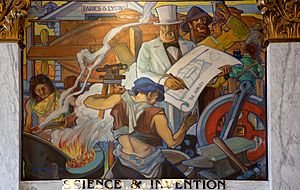John Augustus Walker facts for kids
John Augustus Walker (1901–1967) was a famous artist from the Gulf Coast region of Alabama. He lived during the Great Depression, a time when many people struggled to find work. John Walker was hired to create art for the Works Progress Administration (WPA), a special government program that helped artists and others find jobs.
Contents
Early Life of an Artist
John Augustus Walker was born in Mobile, Alabama. When he was young, an elementary school teacher named Mayme Simpson first encouraged him to become an artist.
John had to start working early to help his family. He worked long hours, from 1 p.m. to 1 a.m. every day, at the Mobile & Ohio Freight Department. Even with this tough schedule, he made sure to get enough sleep so he could spend his free time studying drawing and painting. He began his art lessons with Edmund C. DeCelle in Mobile.
Learning and Growing as an Artist
A work transfer to St. Louis turned out to be a great opportunity for John Walker. It allowed him to join the St. Louis School of Fine Arts. There, he learned from talented teachers like Victor Holm, Edmund H. Wuerpel, and Fred Green Carpenter. After six years of study, he spent several more years exploring art in museums in New York and Chicago. John Walker was also greatly inspired by the well-known Welsh painter and muralist, Frank Brangwyn.
In 1926, John Walker showed his art at an exhibition in St. Louis. Later, he had two art shows in Mobile: one with another artist in 1929, and a solo show in 1933. The solo show received a wonderful review in the Mobile Press-Register newspaper. The review said his watercolor paintings were "among the most beautiful ever seen in Mobile." It praised his delicate style and how he showed beauty in his art.
John Walker's Artworks
John Walker was known as a very hardworking artist. He spent many hours in his studio in Mobile. His paintings often used bright colors, which he loved after visiting Cuba and Key West. He continued to use these vibrant colors in his art after traveling across the United States and the Gulf Coast.
His art, both for businesses and public spaces, often featured strong, dark outlines and bold brushstrokes. John Walker enjoyed painting many different subjects. These included Mardi Gras scenes, fantasy art, historical moments, landscapes, and portraits.
John Walker's watercolor paintings are still highly valued today, especially along the Alabama Gulf Coast. His artworks can be found in many homes in the St. Louis area and throughout Alabama. He is especially remembered for his large murals in Mobile's old City Hall building, which is now the History Museum of Mobile. He also created murals for Smith Bakery (which are now gone) and designs for the Federal Building Courtroom. Many public schools in Alabama also display his paintings.
Besides his paintings, John Walker was also famous for designing floats, stage sets, and costumes for Mardi Gras. Many of his beautiful float designs are still shown in museums today. He won many local, state, and national awards for his work. He also helped start the Mobile Art Guild and taught art there.
Historical Panorama of Alabama Agriculture
One of John Walker's most famous projects is the Historical Panorama of Alabama Agriculture. This series of paintings was paid for by the Works Progress Administration (WPA). The Alabama Extension Service asked him to create them for the 1939 Alabama State Fair. John Walker was supposed to paint 29 murals, but because he had limited time, he only completed ten. He used tempera watercolor paints for these, thinking they would only be temporary. He usually preferred using oil paints, which are more durable.
After being shown at the Alabama State Fair, the paintings traveled to Shreveport for the 1939 Louisiana State Fair. Afterward, they were sent to the Alabama Polytechnic Institute (now Auburn University) in Auburn. They were stored in an attic for almost 50 years before being found again in the 1980s and restored.
Even though these murals were meant to be temporary, they are now very important historical items for the Alabama Cooperative Extension System. They are considered excellent examples of WPA art from the Great Depression era.


